Related Research Articles

Fetish fashion is any style or appearance in the form of a type of clothing or accessory, created to be extreme, revealing, skimpy, or provocative in a fetishistic manner. These styles are by definition not worn by the majority of people; if everyone wears an item, it cannot have fetishistic, special nature. They are usually made of materials such as leather, latex or synthetic rubber or plastic, nylon, PVC, spandex, fishnet, and stainless steel. Some fetish fashion items include: stiletto heel shoes and boots, hobble skirts, corsets, collars, full-body latex catsuits, stockings, miniskirt, crotchless underwear, jockstraps, diapers, garters, locks, rings, zippers, eyewear, handcuffs, and stylized costumes based on more traditional outfits, such as wedding dresses that are almost completely see-through lace, or lingerie for men.
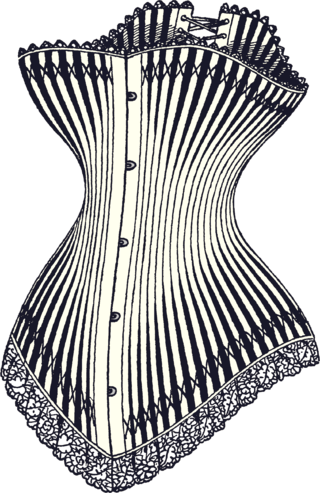
A corset is a support undergarment worn to hold and train the torso into the desired shape and posture. They are traditionally constructed out of fabric with boning made of whalebone or steel, a stiff panel in the front called a busk which holds the torso rigidly upright, and some form of lacing which allows the garment to be tightened. Corsets were an essential undergarment in European women's fashion from the 17th century to the early 20th century. In the 17th and 18th centuries they were commonly known as "stays" and had a more conical shape. This later evolved into the curvaceous 19th century form which is commonly associated with the corset today. By the beginning of the 20th century, shifting gender roles and the onsets of World War I and II led the corset to be largely discarded by mainstream fashion.
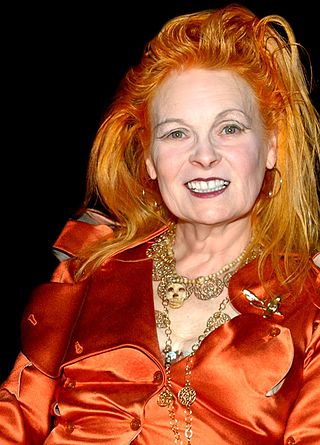
Dame Vivienne Isabel Westwood was a British fashion designer and businesswoman, largely responsible for bringing modern punk and new wave fashions into the mainstream. In 2022, Sky Arts ranked her the 4th most influential artist in Britain of the last 50 years.
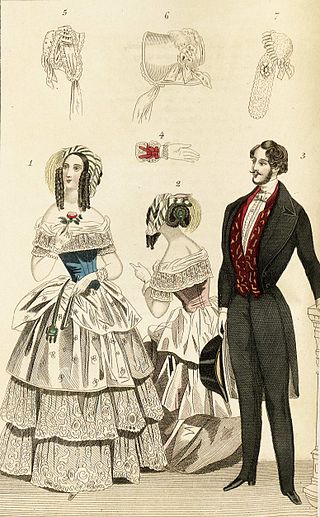
Victorian fashion consists of the various fashions and trends in British culture that emerged and developed in the United Kingdom and the British Empire throughout the Victorian era, roughly from the 1830s through the 1890s. The period saw many changes in fashion, including changes in styles, fashion technology and the methods of distribution. Various movement in architecture, literature, and the decorative and visual arts as well as a changing perception of gender roles also influenced fashion.

Heather Renée Sweet, known professionally as Dita Von Teese, is an American vedette, burlesque dancer, model, and businesswoman. She is credited with re-popularizing burlesque performance, earning the moniker "Queen of Burlesque".

Tightlacing is the practice of wearing an increasingly tightly laced corset to achieve cosmetic modifications to the figure and posture or to experience the sensation of bodily restriction. The process originates in mid-19th century Europe and was highly controversial. At the peak of the prevalence of tightlacing, there was much public backlash both from medical doctors and dress reformers, and it was often ridiculed as vain by the general public. Due to a combination of evolving fashion trends, social change regarding the roles of women, and material shortages brought on by World War I and II, tightlacing, and corsets in general, fell out of favor entirely by the early 20th century.

Leigh Bowery was an Australian performance artist, club promoter, and fashion designer. Bowery was known for his conceptual, flamboyant, and outlandish costumes and makeup, as well as his live performances.

A crinoline is a stiff or structured petticoat designed to hold out a skirt, popular at various times since the mid-19th century. Originally, crinoline described a stiff fabric made of horsehair ("crin") and cotton or linen which was used to make underskirts and as a dress lining. The term crin or crinoline continues to be applied to a nylon stiffening tape used for interfacing and lining hemlines in the 21st century.
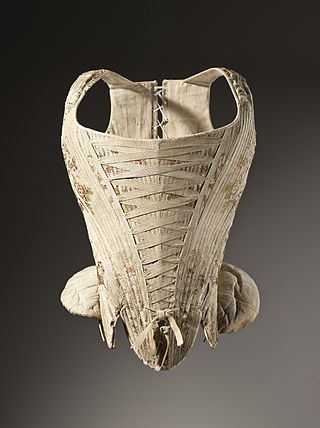
The corset is a supportive undergarment for women, dating, in Europe, back several centuries, evolving as fashion trends have changed and being known, depending on era and geography, as a pair of bodies, stays and corsets. The appearance of the garment represented a change from people wearing clothes to fit their bodies to changing the shape of their bodies to support and fit their fashionable clothing.

1860s fashion in European and European-influenced countries is characterized by extremely full-skirted women's fashions relying on crinolines and hoops and the emergence of "alternative fashions" under the influence of the Artistic Dress movement.
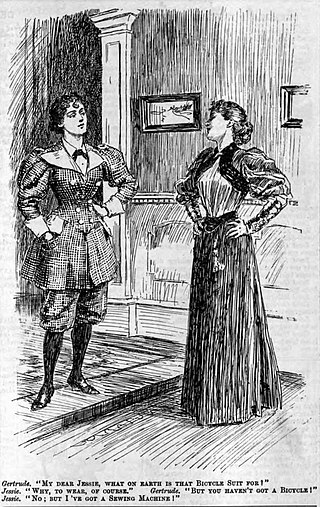
Victorian dress reform was an objective of the Victorian dress reform movement of the middle and late Victorian era, led by various reformers who proposed, designed, and wore clothing considered more practical and comfortable than the fashions of the time.

1840s fashion in European and European-influenced clothing is characterized by a narrow, natural shoulder line following the exaggerated puffed sleeves of the later 1820s and 1830s. The narrower shoulder was accompanied by a lower waistline for both men and women.

Gareth Pugh is an English fashion designer based in London. He is known for his unconventional use of volume and form when designing outfits, and his work is described as performance art. He achieved prominence in the Kashpoint's Autumn 2005 Alternative Fashion Week group show, and he made his solo premiere in London's Fall 2006 fashion week. Due to his focus on experimental fashion, Pugh has had limited success selling wearable clothes. Instead, his projects are funded through patronage by Rick Owens and Michèle Lamy. His designs have been sported by notable performers, including Kylie Minogue, Beyoncé, and Lady Gaga.

Metal corsets are a type of historical corset or bodice made entirely out of metal, usually iron or steel. The metal corset was popularly claimed to have been introduced to France by Catherine de' Medici in the 16th century, although this is now considered a myth. The idea that such garments were worn for fashionable purposes is debatable, with fashion historians now regarding such claims sceptically. Many of the original metal bodices that have survived are now believed to have been intended for medical purposes as orthopaedic support garments and back braces. Such garments were described by the French army surgeon Ambroise Paré in the 16th century as a remedy for the "crookednesse of the Bodie."

Stephen Jones OBE is a British milliner based in London, who is considered one of the most radical and important milliners of the late 20th and early 21st centuries. He is also one of the most prolific, having created hats for the catwalk shows of many leading couturiers and fashion designers, such as John Galliano at Dior and Vivienne Westwood. His work is known for its inventiveness and high level of technical expertise. Jones co-curated the 2009 exhibition Hats: An Anthology for the Victoria and Albert Museum.

The corset controversy was a moral panic and public health concern around corsets in the 19th century.
Michael Schmidt is a wardrobing, jewelry and interior designer working primarily in the entertainment industry. He is known for working with a variety of innovative materials and techniques, such as a 3-D printed dress he created for Dita Von Teese. His clothing has been worn by celebrities such as Madonna, Cher, and the Black Eyed Peas.

Violet Chachki is the stage name of Paul Jason Dardo, an American drag queen, burlesque/aerial performer, content creator, model, and recording artist best known for winning the seventh season of RuPaul's Drag Race. Violet Chachki is genderfluid and uses she/her and they/them pronouns.
AngloMania: Tradition and Transgression in British Fashion was an exhibition curated by Andrew Bolton at the Metropolitan Museum of Art that ran from May 3 to September 4, 2006. The exhibition featured fashion from throughout Europe in the eighteenth-century that was influenced directly by British attitudes, ideas, and trends. However, these were not accurate depictions of British fashion, but idealized depictions of "a nation's notorious vanity, a romance with itself, and the eccentric desire of English designers to re-establish the establishment." The exhibit is composed of nine "theatrical installations containing clothed mannequins and paintings" that contrasted historical and modern aspects of fashion.

Music and fashion have long been closely linked. Artistic movements in music have often been associated with distinct fashions. Both industries have also had considerable influence on each other. Many famous musicians have also had notable styles and influenced fashion.
References
- ↑ Tavares-Teles, Alexandra (21 October 2014). "O artesão de espartilhos". Notícias Magazine (in Portuguese). Retrieved 19 May 2016.
- 1 2 3 Sklar, Monica; Santandrea, Lisa (20 January 2012). "Anarchists of Style: Mr. Pearl". Worn Through. Retrieved 18 May 2016.
- 1 2 3 4 5 6 7 8 9 10 11 12 13 14 von Neuschatz, Delia (12 December 2013). "Mr. Pearl: Couturier Nonpareil". New York Social Diary. Retrieved 18 May 2016.
- ↑ Staff writer (9 March 1987). "Ballet costume for Because We Must by Leigh Bowery and Mr Pearl". collections.vam.ac.uk. Retrieved 19 May 2016.
- 1 2 3 Allwood, Emma Hope (15 April 2016). "Meeting Mr Pearl, the corset-maker who walked for McQueen". Dazed. Retrieved 19 May 2016.
- ↑ Lester, Richard (2013). Dress of the year. Antique Collectors' Club. pp. 141–143. ISBN 9781851497256.
- ↑ O'Carroll, Lisa; Robson, Michael (22 March 2005). "Corset's not true". The Guardian. Retrieved 19 May 2016.
- ↑ "Jean Paul Gaultier evening ensemble made by Mr Pearl. French, spring-summer 2001". The Metropolitan Museum of Art. Retrieved 19 May 2016.
- ↑ Lauder, Velda (2010). Corsets: A Modern Guide. A. & C. Black. p. 157. ISBN 9781408127551.
- ↑ Koda, Harold (2004). Extreme Beauty: The Body Transformed. Metropolitan Museum of Art. p. 99. ISBN 9780300103120.
- ↑ Stern, Mistress Angel (1993). "A Corset Moment With Pearl". Verbal Abuse (3: New Religions). Retrieved 19 May 2016.
- ↑ "Dita Von Teese's wedding dress, 2005". Western Australian Museum. Retrieved 19 May 2016.